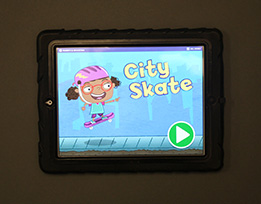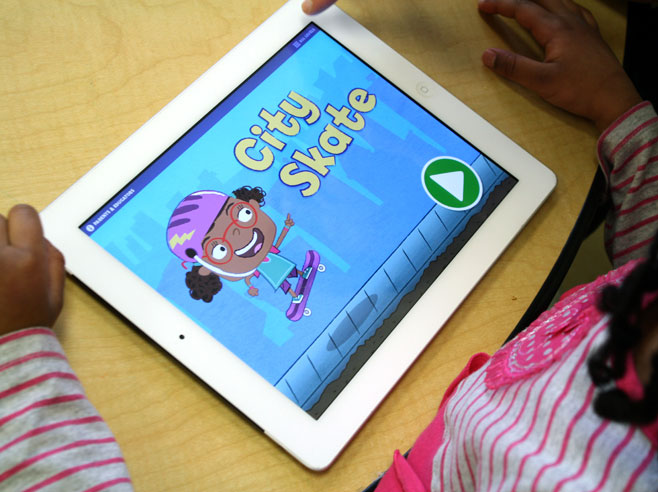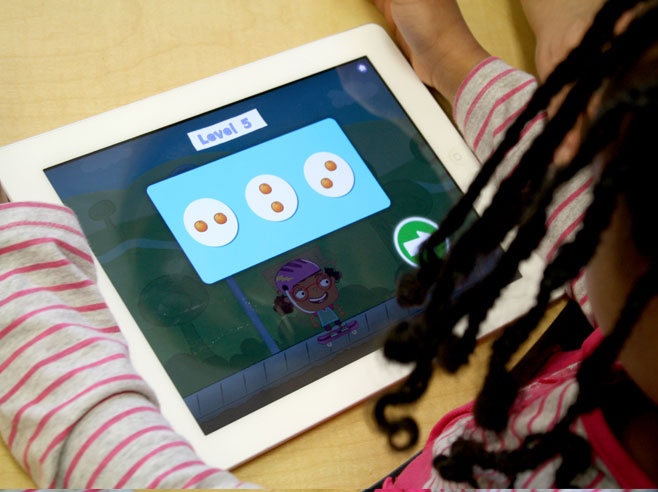Children help Teenie collect groups of two, three, four and five objects as she skateboards through the city.
Materials

- City Skate digital game on the iPad
Preparation
- Make sure the iPads are adequately charged and City Skate is installed.
Directions
- Start with one iPad (keep any additional iPads out of reach).
- Introduce the game. Tell the children they are going to play a game called City Skate on an iPad. Tell them that everyone will get a chance to play. Explain that the object of the game is to help Teenie jump so she can collect the objects above her head.
- Demonstrate how to play the game. Talk the children through the training level at the beginning of the game. In the animated tutorial, Gracie shows how to make Teenie jump, and then how do a super jump. Have a child demonstrate each of these jumps when Gracie prompts them. Then have another child complete the next step of the training, in which Teenie needs to capture all the sets with two objects. Gracie helps by saying when Teenie should jump or super-jump to collect two objects, and when not to jump because the set does not have two objects.
- Distribute any additional iPads and invite the children to play the game. Be available throughout game play. Allow children to play on their own or with a partner while you observe and engage them in conversations about the math. Choose moments to interact that do not interrupt game play, such as the start of a new level, or when a child is struggling and is open to assistance.
- Promote math talk and learning:
- Help children identify which sets have the correct number of objects and which sets don’t. Ask, Which one has two objects? Can you count this one?
- Have children shout out the number of objects when they see a set appear.
- As the game advances, the levels become more difficult, Teenie skates faster, and the sets of objects become larger. Assist children having problems with the math. Reassure children that it’s okay if the game feels hard. It will get easier as they practice. Here are some typical problems children experience and some suggested solutions:
- If a child has trouble figuring out the right time to make the friend jump, show the child how to tap the screen only when the correct sets appear. One way to do this is for you to control the friend while the child identifies the correct sets to catch. The ability to recognize the number of objects in a set is essential for subitizing, so have the child focus on identifying the correct sets to gather while you jump to catch them. Don’t overwhelm the child with too many tasks at once. Once the child feels comfortable identifying the correct sets, have the child try the game all by him- or herself and tap to jump and collect the sets.
- Assist children as needed with the mechanics of game play, but keep the main focus on math talk.
- If a child has trouble timing the jumps, consider controlling the friend yourself while the child names the number of objects and tells you when to jump. Then encourage the child to join you in playing the game. Offer positive reinforcement and support.
- If a child has trouble tapping twice for a super jump, you may want to demonstrate, or simply move the child’s finger until the timing becomes intuitive. Sometimes just saying, “Tap, tap” at the appropriate moment can help the child to get into the rhythm of tapping twice in rapid succession.
- Children learn from and teach each other — especially when they’re playing! Encourage simultaneous or collaborative play for struggling children. Invite more advanced children to explain how they know when the correct number of objects appears.
- Overall, have fun and allow the children to have fun too. They’ll learn while playing!

